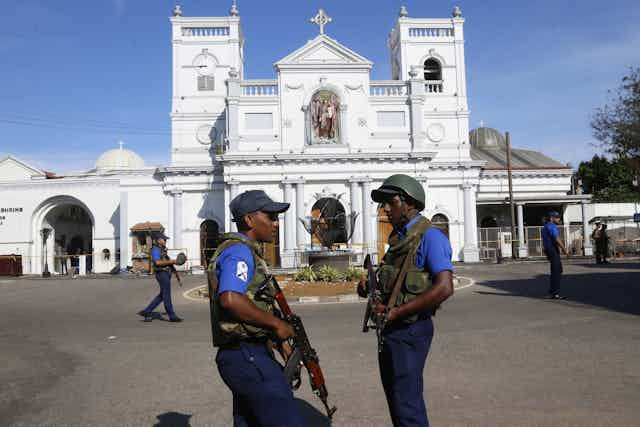Sri Lanka has long been subject to extremist violence. Easter Sunday’s coordinated bomb blasts, which killed almost 300 and injured hundreds more, are the latest in a long history of ethno-religious tragedies.
While no one has yet claimed responsibility for the attacks, 24 people have been arrested. Three police were killed in their capture.
The Sri Lankan government has blamed the attacks on the National Thowheeth Jama’ath (NTJ), a radical Islamist group known for vandalising Buddhist statues.
These attacks are different from previous ethno-religious violence in Sri Lanka. By fomenting generalised religious hatred, they appear to have more in common with Al-Qaeda, which has sought specific political change.
Read more: Who are Sri Lanka's Christians?
For many, the bomb blasts immediately recalled Sri Lanka’s ethnic civil war. The war was fought between the Liberation Tigers of Tamil Eelam (Tamil Tigers) and the Sri Lanka government from 1983 until 2009.
In its final weeks, around 40,000 mostly Tamil civilians were killed, bringing the war’s total toll to more than 100,000 from a population of around 20 million.
The Tamil Tigers were completely destroyed in 2009. Many Tigers, including their leader, were summarily executed. There remains much bitterness among Tamils towards the ethnic majority Sinhalese, but there is no appetite for renewing a war that ended so disastrously.
A history of unrest
Ethnic tensions in Sri Lanka were high prior to independence in 1948, and stoked by the 1956 election of the Sri Lanka Freedom Party under Prime Minister Solomon Bandaranaike.
Bandaranaike proclaimed himself “defender of the besieged Sinhalese culture”, and oversaw the introduction of the Sinhala Only Act. The act privileged the country’s majority Sinhalese population and their religion of Buddhism over the minority Hindu and Muslim Tamils. The fallout from this legislation forced Bandaranaike to backtrack, but he was assassinated in 1959 by an extremist Buddhist monk for doing so.
Inter-ethnic tensions continued with outbursts of mob violence. In 1962, there was an attempted military coup, and in 1964, around 600,000 third and fourth generation “Indian” Tamils were forcibly removed to India.
In 1972, and again in 1987, the predominantly Sinhalese Marxist Janatha Vimukthi Peramuna party (JVP) launched insurrections that were bloodily suppressed. Clashes between Sinhalese and Tamils in 1983 led to an attack on a Sri Lankan army convoy. This sparked the “Black July” Sinhalese rampage against ethnic Tamils, leaving at least 3,000 dead and marking the start of the inter-ethnic civil war.
The war was noted for its bitterness, with the Tamil Tigers using suicide bombing as a tactical weapon, as well as for targeted political assassinations. India intervened in the war in 1987. In retribution, a Tamil Tiger suicide bomber assassinated former Indian Prime Minister Rajiv Gandhi in 1991.
Read more: Violent Buddhist extremists are targeting Muslims in Sri Lanka
Extremist violence isn’t new
Sri Lanka’s Muslims are predominantly ethnic Tamils and make up about 10% of the population. They have been at the margins of these more recent conflicts – excluded as Tamil speakers, but at odds with the more numerous Hindu Tamils. However, they also have long been subject to Sinhalese persecution, with anti-Muslim riots dating back at least as far as the early 20th century.
As the Tamil Tiger war progressed, Sinhalese Buddhism became more radicalised. Some Sinhalese claimed that all of Sri Lanka should be exclusively Buddhist. With the Tamil Tigers defeated, Sri Lanka’s non-Buddhist communities were again persecuted. This culminated in 2013 with a Buddhist attack on a mosque. Anti-Muslim riots in 2014 resulted in a ten day state of emergency. Last year, there were more anti-Muslim riots. Buddhist monks have also disrupted Christian church services.
Read more: Explainer: Why Sri Lanka is sliding into political turmoil, and what could happen next
Sri Lanka’s history of extremist violence, then, is far from new. Sinhalese Buddhist chauvinism has been the driver of much of this conflict. It may be that the Colombo East bombings are a reaction to recent ethnic persecution.
But if so, this raises the question of why Christian churches and upmarket hotels were bombed, rather than symbols of the Sinhalese Buddhist community. One can speculate about the logic of radicalisation and its possible manifestations. It is possible that, if Islamist-inspired, the bombings were not a direct retaliation for last year’s anti-Muslim riots, but part of a wider jihadi agenda.
It is instructive that, when the suspected terrorists were arrested and weapons found, three police were shot dead. Clearly, whoever was responsible was well trained, and there have been suggestions of international links. This contributes to speculation of returned Islamic State fighters having joined NTJ.
The Sri Lankan government was slow to release details of those believed responsible, as it knows ethnic and religious tensions are easy to spark. Identification of responsibility could well provide fuel for another round of inter-ethnic bloodletting.
If NTJ links are proven, or if the more radical elements of the Buddhist community are persuaded by wider speculation, it is likely Sri Lanka’s Tamil Muslims will bear the brunt of their reprisals. It is in this manner that Sri Lanka’s wheel of ethno-religious conflict turns.


